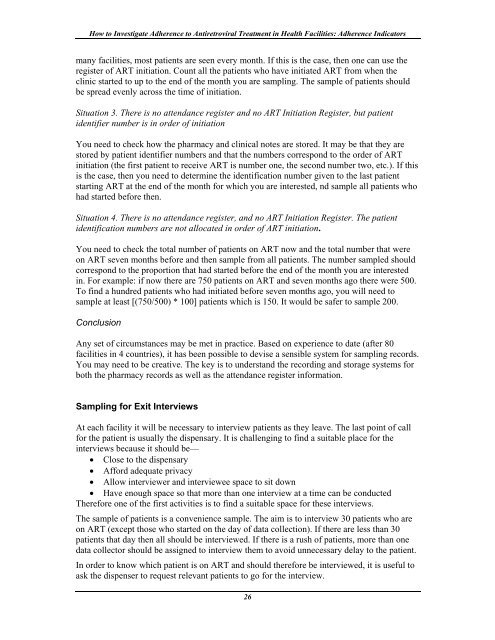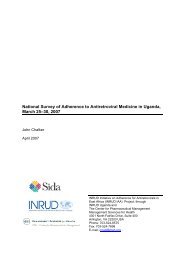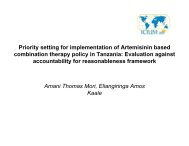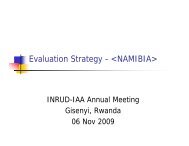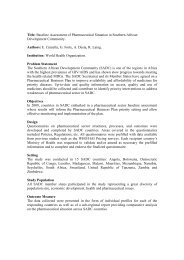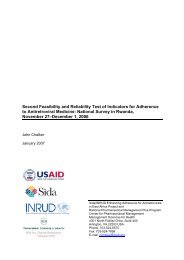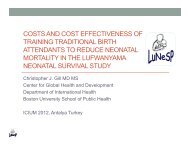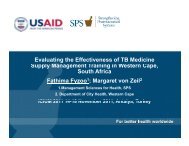How to investigate Adherence to Antiretroviral Treatment ... - INRUD
How to investigate Adherence to Antiretroviral Treatment ... - INRUD
How to investigate Adherence to Antiretroviral Treatment ... - INRUD
You also want an ePaper? Increase the reach of your titles
YUMPU automatically turns print PDFs into web optimized ePapers that Google loves.
<strong>How</strong> <strong>to</strong> Investigate <strong>Adherence</strong> <strong>to</strong> <strong>Antiretroviral</strong> <strong>Treatment</strong> in Health Facilities: <strong>Adherence</strong> Indica<strong>to</strong>rs<br />
many facilities, most patients are seen every month. If this is the case, then one can use the<br />
register of ART initiation. Count all the patients who have initiated ART from when the<br />
clinic started <strong>to</strong> up <strong>to</strong> the end of the month you are sampling. The sample of patients should<br />
be spread evenly across the time of initiation.<br />
Situation 3. There is no attendance register and no ART Initiation Register, but patient<br />
identifier number is in order of initiation<br />
You need <strong>to</strong> check how the pharmacy and clinical notes are s<strong>to</strong>red. It may be that they are<br />
s<strong>to</strong>red by patient identifier numbers and that the numbers correspond <strong>to</strong> the order of ART<br />
initiation (the first patient <strong>to</strong> receive ART is number one, the second number two, etc.). If this<br />
is the case, then you need <strong>to</strong> determine the identification number given <strong>to</strong> the last patient<br />
starting ART at the end of the month for which you are interested, nd sample all patients who<br />
had started before then.<br />
Situation 4. There is no attendance register, and no ART Initiation Register. The patient<br />
identification numbers are not allocated in order of ART initiation.<br />
You need <strong>to</strong> check the <strong>to</strong>tal number of patients on ART now and the <strong>to</strong>tal number that were<br />
on ART seven months before and then sample from all patients. The number sampled should<br />
correspond <strong>to</strong> the proportion that had started before the end of the month you are interested<br />
in. For example: if now there are 750 patients on ART and seven months ago there were 500.<br />
To find a hundred patients who had initiated before seven months ago, you will need <strong>to</strong><br />
sample at least [(750/500) * 100] patients which is 150. It would be safer <strong>to</strong> sample 200.<br />
Conclusion<br />
Any set of circumstances may be met in practice. Based on experience <strong>to</strong> date (after 80<br />
facilities in 4 countries), it has been possible <strong>to</strong> devise a sensible system for sampling records.<br />
You may need <strong>to</strong> be creative. The key is <strong>to</strong> understand the recording and s<strong>to</strong>rage systems for<br />
both the pharmacy records as well as the attendance register information.<br />
Sampling for Exit Interviews<br />
At each facility it will be necessary <strong>to</strong> interview patients as they leave. The last point of call<br />
for the patient is usually the dispensary. It is challenging <strong>to</strong> find a suitable place for the<br />
interviews because it should be—<br />
• Close <strong>to</strong> the dispensary<br />
• Afford adequate privacy<br />
• Allow interviewer and interviewee space <strong>to</strong> sit down<br />
• Have enough space so that more than one interview at a time can be conducted<br />
Therefore one of the first activities is <strong>to</strong> find a suitable space for these interviews.<br />
The sample of patients is a convenience sample. The aim is <strong>to</strong> interview 30 patients who are<br />
on ART (except those who started on the day of data collection). If there are less than 30<br />
patients that day then all should be interviewed. If there is a rush of patients, more than one<br />
data collec<strong>to</strong>r should be assigned <strong>to</strong> interview them <strong>to</strong> avoid unnecessary delay <strong>to</strong> the patient.<br />
In order <strong>to</strong> know which patient is on ART and should therefore be interviewed, it is useful <strong>to</strong><br />
ask the dispenser <strong>to</strong> request relevant patients <strong>to</strong> go for the interview.<br />
26


